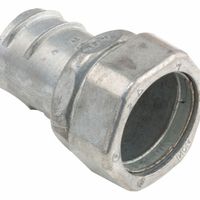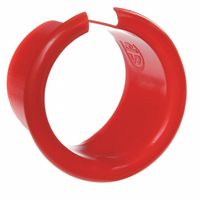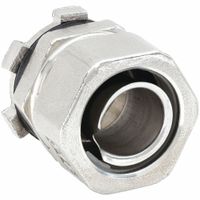Call +(254) 703 030 000 / 751 483 999 / 721 704 777
- Home
- Electrical
- Conduit Fittings Strut Channel Framing
- Conduit Fittings
- Flexible Conduit Fmc Fnc Fittings
.....Read More
Frequently Asked Questions
What is the difference between flexible metal conduit (FMC) and flexible nonmetallic conduit (FNC)?
Flexible Metal Conduit (FMC) and Flexible Nonmetallic Conduit (FNC) differ primarily in material composition, application, and characteristics:
1. **Material Composition**:
- **FMC**: Made from helically wound, interlocked metal strips, typically steel or aluminum. It provides a metallic pathway for electrical wiring.
- **FNC**: Constructed from nonmetallic materials like PVC or other plastic compounds, offering a non-conductive pathway.
2. **Protection and Durability**:
- **FMC**: Offers excellent mechanical protection against physical damage and is resistant to crushing. It also provides some degree of electromagnetic interference (EMI) shielding.
- **FNC**: Less resistant to physical damage compared to FMC but offers good protection against moisture and corrosion. It is not suitable for environments requiring EMI shielding.
3. **Flexibility and Installation**:
- **FMC**: Highly flexible, allowing for easy installation in tight or complex spaces. It can be bent and shaped without special tools.
- **FNC**: Also flexible but generally less so than FMC. It is lightweight and easier to cut, making it suitable for simpler installations.
4. **Applications**:
- **FMC**: Commonly used in commercial and industrial settings where mechanical protection and flexibility are needed, such as in machine tools and equipment connections.
- **FNC**: Typically used in residential and light commercial applications, especially in areas prone to moisture, like underground or outdoor installations.
5. **Cost**:
- **FMC**: Generally more expensive due to its metal construction and added protective features.
- **FNC**: More cost-effective, especially for applications where metal protection is not necessary.
6. **Code Compliance**:
- Both types must comply with relevant electrical codes, but their use is dictated by specific environmental and safety requirements.
How do you install flexible metal conduit?
1. **Plan the Layout**: Determine the path for the conduit, ensuring it avoids obstacles and minimizes bends.
2. **Measure and Cut**: Measure the required length of the conduit. Use a hacksaw or conduit cutter to cut it to size, ensuring a clean, straight edge.
3. **Deburr the Edges**: Use a deburring tool or file to smooth the cut edges to prevent damage to wires.
4. **Install Connectors**: Attach appropriate connectors to the ends of the conduit. Secure them tightly using a wrench.
5. **Bend the Conduit**: If necessary, use a flexible conduit bender to achieve the desired bends, ensuring not to exceed the bend radius to avoid kinking.
6. **Secure the Conduit**: Use conduit straps or hangers to secure the conduit to walls or ceilings at regular intervals, typically every 3-4 feet, and within 12 inches of each box or fitting.
7. **Pull the Wires**: Feed the electrical wires through the conduit. Use fish tape if needed to guide the wires through longer or more complex runs.
8. **Connect to Boxes**: Attach the conduit to electrical boxes using the installed connectors. Ensure a tight fit to maintain grounding and protection.
9. **Grounding**: Ensure the conduit is properly grounded, especially if used as a grounding conductor.
10. **Inspect and Test**: Check the entire installation for secure connections and proper support. Test the electrical system to ensure functionality and safety.
11. **Seal and Protect**: If the conduit is exposed to moisture, use appropriate sealing methods to protect the connections and wires.
What are the common applications for flexible nonmetallic conduit?
Flexible nonmetallic conduit is commonly used in various applications due to its versatility, durability, and ease of installation. Here are some of its common applications:
1. **Residential Wiring**: It is often used in homes for routing electrical wires in walls, ceilings, and floors. Its flexibility allows it to navigate around obstacles and tight spaces easily.
2. **Commercial Buildings**: In commercial settings, flexible nonmetallic conduit is used for power distribution, lighting circuits, and communication cables. It is ideal for environments where frequent changes or additions to the wiring system are anticipated.
3. **Industrial Environments**: It is used in industrial facilities to protect wiring in areas with high moisture, dust, or chemical exposure. Its nonmetallic nature makes it resistant to corrosion and suitable for harsh environments.
4. **Outdoor Installations**: Flexible nonmetallic conduit is suitable for outdoor applications, such as landscape lighting and exterior power outlets, due to its resistance to UV rays and weather conditions.
5. **Data Centers**: It is used to organize and protect data and communication cables, ensuring efficient cable management and reducing the risk of interference.
6. **Automotive and Marine Applications**: In vehicles and boats, it is used to protect wiring from vibration, moisture, and other environmental factors.
7. **Temporary Installations**: Its ease of installation and removal makes it ideal for temporary setups, such as construction sites or event venues, where electrical systems need to be quickly deployed and dismantled.
8. **HVAC Systems**: It is used to route control and power cables for heating, ventilation, and air conditioning systems, providing protection against temperature fluctuations and mechanical damage.
9. **Agricultural Settings**: It is used in farms and greenhouses to protect electrical wiring from moisture, chemicals, and physical damage.
These applications highlight the conduit’s adaptability and protective qualities, making it a preferred choice in diverse settings.
Can flexible conduit be used outdoors?
Yes, flexible conduit can be used outdoors, but certain conditions and specifications must be met to ensure safety and compliance with electrical codes. When using flexible conduit outdoors, it is crucial to select a type that is specifically designed for outdoor use. This typically means choosing a conduit that is resistant to moisture, UV radiation, temperature fluctuations, and other environmental factors.
Types of flexible conduit suitable for outdoor use include:
1. **Liquid-tight Flexible Metal Conduit (LFMC):** This type of conduit is coated with a waterproof plastic jacket, making it suitable for wet and damp locations. It provides protection against moisture and is often used in outdoor applications.
2. **Liquid-tight Flexible Nonmetallic Conduit (LFNC):** Made from a durable plastic material, LFNC is resistant to corrosion and moisture, making it ideal for outdoor installations. It is also UV-resistant, which helps prevent degradation from sunlight exposure.
3. **Flexible Metallic Conduit (FMC):** While not inherently waterproof, FMC can be used outdoors if additional protective measures, such as sealing and proper fittings, are employed to prevent moisture ingress.
When installing flexible conduit outdoors, it is important to:
- Ensure that all connections and fittings are properly sealed to prevent water ingress.
- Use weatherproof junction boxes and enclosures to protect electrical connections.
- Secure the conduit adequately to prevent movement and damage from wind or other environmental factors.
- Follow local electrical codes and standards, such as the National Electrical Code (NEC) in the United States, which provide guidelines for outdoor conduit installations.
By selecting the appropriate type of flexible conduit and following proper installation practices, it is possible to safely and effectively use flexible conduit in outdoor environments.
What fittings are compatible with flexible metal conduit?
Flexible metal conduit (FMC) is compatible with a variety of fittings designed to ensure secure connections and maintain the integrity of the electrical system. The most common fittings compatible with FMC include:
1. **Connector Fittings**: These are used to connect the conduit to electrical boxes or enclosures. They typically have a threaded end that screws into the box and a clamp or compression end that secures the conduit.
2. **Couplings**: These fittings join two sections of flexible metal conduit together. They can be set-screw or compression types, depending on the application and the level of protection required.
3. **Elbow Fittings**: Used to change the direction of the conduit run, elbow fittings are available in various angles, such as 45 or 90 degrees, to accommodate different routing needs.
4. **Liquid-tight Fittings**: When using liquid-tight flexible metal conduit (LFMC), liquid-tight fittings are necessary. These fittings provide a watertight seal, making them suitable for wet or damp environments.
5. **Strain Relief Fittings**: These are used to prevent tension on the conduit from affecting the connections, providing additional support and reducing the risk of damage.
6. **Grounding Fittings**: These ensure that the conduit is properly grounded, which is essential for safety and compliance with electrical codes.
7. **Insulated Throat Fittings**: These fittings have an insulated lining to protect the wires from abrasion and to provide additional electrical insulation.
8. **Snap-in Fittings**: These are used for quick installations where the conduit needs to be easily attached or detached from boxes or panels.
When selecting fittings for flexible metal conduit, it is important to ensure they are appropriately sized for the conduit diameter and meet the relevant electrical codes and standards for the specific application.
How do you cut flexible conduit to length?
To cut flexible conduit to length, follow these steps:
1. **Measure and Mark**: Determine the required length of the conduit using a measuring tape. Mark the cutting point with a permanent marker or a piece of tape for accuracy.
2. **Select the Right Tool**: Use a hacksaw with a fine-toothed blade or a rotary tool with a cutting wheel. For smaller diameters, a conduit cutter specifically designed for flexible conduit can also be used.
3. **Secure the Conduit**: Place the conduit on a stable work surface. Use a vise or clamps to hold it securely in place, ensuring it doesn't move during cutting.
4. **Cut the Conduit**: Align the tool with the marked line. If using a hacksaw, make slow, steady strokes to avoid deforming the conduit. For a rotary tool, apply gentle pressure and let the tool do the work. Ensure the cut is straight and clean.
5. **Deburr the Edges**: After cutting, the edges may be sharp or have burrs. Use a deburring tool, file, or sandpaper to smooth the edges, ensuring they are safe to handle and won't damage wires.
6. **Check the Fit**: Verify the cut length by fitting the conduit in place. Make any necessary adjustments by trimming slightly if needed.
7. **Clean Up**: Remove any debris or metal shavings from the work area to maintain a safe environment.
By following these steps, you can accurately and safely cut flexible conduit to the desired length.
What are the advantages of using flexible conduit over rigid conduit?
Flexible conduit offers several advantages over rigid conduit:
1. **Ease of Installation**: Flexible conduit is easier to install, especially in tight or complex spaces. It can be bent and maneuvered around obstacles without the need for additional fittings or tools, reducing installation time and labor costs.
2. **Versatility**: It is suitable for a variety of applications, including areas with vibration or movement, such as machinery or equipment connections. Its adaptability makes it ideal for retrofitting or upgrading existing systems.
3. **Vibration and Movement Accommodation**: Flexible conduit can absorb vibrations and accommodate movement, reducing the risk of damage to the wiring inside. This makes it ideal for use in environments with machinery or where seismic activity is a concern.
4. **Expansion and Contraction**: It can expand and contract with temperature changes, reducing the risk of cracking or breaking, which is a common issue with rigid conduit in fluctuating temperatures.
5. **Cost-Effectiveness**: While the initial cost of flexible conduit may be higher, the reduced need for fittings and the ease of installation can lead to overall cost savings in labor and materials.
6. **Accessibility**: It allows for easier access to the wiring for maintenance or upgrades, as it can be easily cut and reconfigured without the need for specialized tools.
7. **Aesthetic and Space-Saving**: Flexible conduit can be routed in a more aesthetically pleasing manner and can fit into spaces where rigid conduit would be impractical or impossible.
8. **Safety**: It provides a protective layer for electrical wiring, reducing the risk of electrical hazards such as short circuits or fires.
These advantages make flexible conduit a preferred choice in many applications where adaptability, ease of installation, and durability are important.





